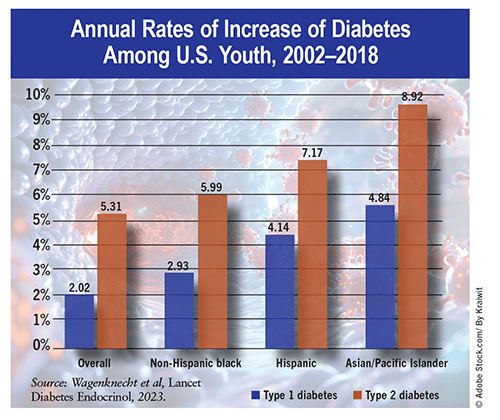US Pharm. 2024;49(11):14.
According to the CDC and the recent National Diabetes Statistics Report, more than 38 million people in the United States (11.6% of the population) have diabetes. Data trends have shown general declines in the incidence of type 1 diabetes (T1D) and type 2 diabetes (T2D) since 2009, with some increases between 2017 and 2020. Improvements in healthcare services and access, treatment options, lifestyle interventions, and self-management practices have likely contributed to these favorable trends. However, the incidence of diabetes among U.S. youth (ages 0-19 years) has been increasing steadily since 2002.

SEARCH Study: The SEARCH for Diabetes in Youth Study (Diabetes Care, 2023) evaluated incidences of T1D and T2D in approximately 5 million persons aged <20 years between 2002 and 2018. The population sample was representative of the general public with regard to race, ethnicity, age, parental education, and household income. Significant annual increasing linear effects were determined for T1D and T2D (2.02% and 5.31%, respectively). Peak age of diagnosis was 10 years for T1D and 16 years for T2D. Seasonal peaks were also significant, with T1D diagnoses peaking in January and T2D diagnoses in August. By the end of the study period, overall incidence of T2D had surpassed that of T1D in youth aged 15 to 19 years (19.7 per 100,000 vs. 14.6 per 100,000, respectively).
Health Disparities: Incidences of T1D and T2D were highest among young people from racial and ethnic minority groups. Asian/Pacific Islander youth had the greatest annual rate of increase for T1D (4.84%), followed by Hispanic (4.14%) and non-Hispanic black youth (2.93%). Annual rates of increase for T2D were also highest for these groups (8.92%, 7.17%, and 5.99%, respectively). With regard to peak age of diagnosis, Asian/Pacific Islander and Hispanic youth had an earlier peak for T1D than other racial and ethnic groups (9 years vs. 10-11 years, respectively). For T2D, non-Hispanic black youth had an earlier peak age than all other groups (13 years vs. 16 years, respectively).
Projections: Over the next 40 years, the incidence of diabetes is expected to continue rising among youth. SEARCH Study projections indicate an increasing incidence of 115,000 T1D cases (65%) by 2060. For T2D, the constant incidence and increasing incidence are anticipated to climb by 20,000 cases (70%) and 192,000 cases (700%), respectively. Mathematical models based on past trends reveal higher predicted incidences for Asian/Pacific Islander, Hispanic/Latino, black, and American Indian/Alaska Native youth than for other races and ethnicities. Preventative measures may help decrease T2D incidence by 2% annually and should be considered once risk factors are identified in children and adolescents. Vigilance among healthcare practitioners is essential to minimize the risk of diabetes-related complications in young people as they approach adulthood.
The content contained in this article is for informational purposes only. The content is not intended to be a substitute for professional advice. Reliance on any information provided in this article is solely at your own risk.
To comment on this article, contact rdavidson@uspharmacist.com.





